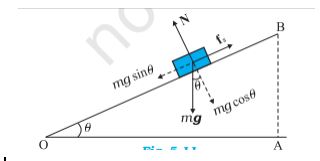
Vipra ShrivastavaSenior Manager - Content
What is Friction?
Friction is the measure of the resistance of motion between two surfaces, fluid layers, or materials. These surfaces must be in contact with each other.
Static Friction
- Static friction is the frictional force or opposing force applied by an object on which an external force is applied.
- When a body is at rest, and a force is applied to it to bring it into motion, the body's frictional force to retain its original state is the static frictional force. Static friction opposes impending motion that would occur if there was no friction.
- The static friction is denoted by- fs, where f is the frictional force, and subscript s denotes the static friction. It does not depend on the area of contact rather varies with the normal force.
-
- (fs)max is the limiting friction. If the force increases beyond (fs)max, the body will start moving.
- (fs)max= μsN.
-
- The coefficient of friction is the ratio of the frictional force opposing the movement of a couple of surfaces in association to the perpendicular force holding the two surfaces together.
- The coefficient of friction is symbolized by the Greek letter mu (μ).
-
- Mathematically, μ = F/N,
- Where F is the frictional force and N is the normal force.
-
- In static friction, the frictional force resists the force applied to an object, and the object remains at rest until the force of static friction is eliminated. The coefficient of friction for static friction is denoted by μs.
- The value of static friction lies between zero and the smallest force required to begin motion.
About this topic in class 11
The topic- static friction is a part of the chapter- laws of motion in the syllabus of class 11. This topic carries a weightage of around 4-5 marks in the examination.
Illustrative Examples
1. Determine the maximum acceleration of a train in which a box lying on its floor will remain stationary, given that the coefficient of static friction is 0.15.
Solution:
Since the acceleration of the box is due to the static friction,
m.a = fs ≤ µs N = µs m g => a ≤ µs g
=> amax = µs g = 0.15 x 10 ms-2 = 1.5 ms-2.
2. What is the coefficient of static friction between the block and the surface?
Solution:
Resolving the weight mg along the two directions,
mg.sin θ = fs=> mg.cos θ = N.
Now, (fs)max = µs N.
(tan θ)max = µmax or θmax = tan-1 µs.
When θ becomes just a little more than θmax, there is a small net force on the block and it begins to slide.
For θmax = 15°, µs= tan(15°)= 0.27.
3. If a box with a mass of 100 kg is pushed, find the static friction.
Solution:
Weight of the box is
w=mg=(100kg)(9.80m/s2)=980N,
If the coefficient of static friction is 0.45, then
(fs)max = µs N=(0.45)(980N)=440N
Image Source: NCERT
FAQs on Static Friction
Q: What is the difference between static friction and kinetic friction?
Q: What is an example of static friction?
Q: Who propounded the concept of friction?
Q: What is the unit of the coefficient of friction?
News & Updates
Physics Laws of Motion Exam
Student Forum
Popular Courses After 12th
Exams: BHU UET | KUK Entrance Exam | JMI Entrance Exam
Bachelor of Design in Animation (BDes)
Exams: UCEED | NIFT Entrance Exam | NID Entrance Exam
BA LLB (Bachelor of Arts + Bachelor of Laws)
Exams: CLAT | AILET | LSAT India
Bachelor of Journalism & Mass Communication (BJMC)
Exams: LUACMAT | SRMHCAT | GD Goenka Test
